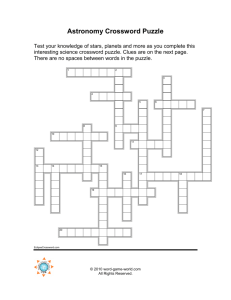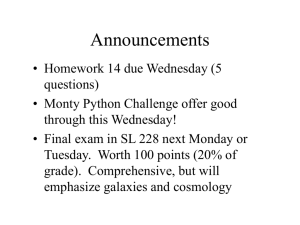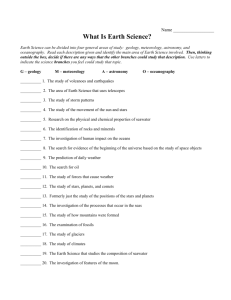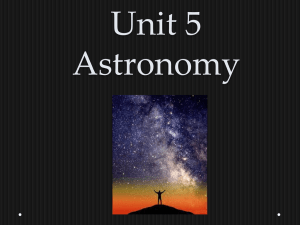AIM: HOW DO STARS FORM?
advertisement
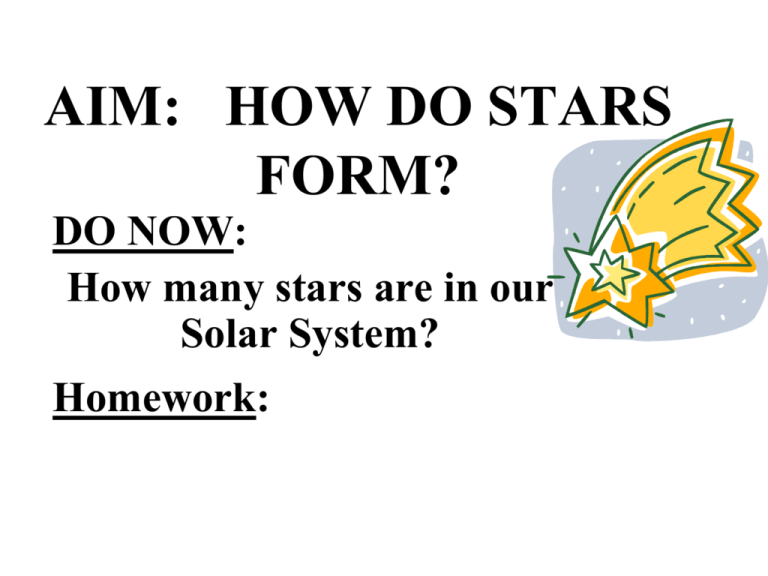
AIM: HOW DO STARS FORM? DO NOW: How many stars are in our Solar System? Homework: What are stars? v Balls of gases that give off light & heat energy. v Most stars are made up of hydrogen & helium. What is the closest star to the Earth? The Sun: • One of billions of stars • Avg. size (main sequence star) • A million times greater volume than the earth Why does the sun look big compared to other stars? • Other stars are so far away that they look like points of light. • There are huge distances between stars. • We only have one star (the sun) in our solar system. How are stars formed? v From a spinning cloud of gas & dust called a nebula. Continued spinning & gravity causes materials to squeeze together to form a protostar What is the v The temperature & pressure builds up due to lifecycle of a nuclear reactions (fusion of star? hydrogen to helium) creating energy v The protostar becomes a star when it gives off light & heat. v A star will continue to go through stages as nuclear reactions continue. The Lifecycle of a Star What is the measure of a stars brightness called? MAGNITUDE! This depends upon its temperature, its size and its distance from the earth. The brightness of a star as seen from earth is its__________ apparent brightness. The actual brightness of a star is its__________brightness. absolute LETS REVIEW… • WHY DO STARS APPEAR SO SMALL? • WHAT IS A SPINNING CLOUD OF GAS & DUST? • WHAT 2 GASES MAKE UP MOST STARS? • WHY IS THE SUN SO IMPORTANT? • WHAT IS A MEASURE OF A STARS BRIGHTNESS CALLED? • WHICH TYPE OF STAR IS HOTTER, A BLUE STAR OR RED STAR? (WHY DID YOU PICK YOUR ANSWER?) AIM: What objects are located in our solar system? DO NOW: What are stars? Homework: Handout 16-1 & 16-9 Big 8 Review pgs 65-74 due Thursday What are the names of the planets that orbit the sun? 1. Mercury My 2. Venus Very 3. Earth Excellent 4. Mars Mother _____________________ 5. Jupiter Just 6. Saturn Served 7. Uranus Us 8. Neptune Nachos What does the word “planet” mean? “Wanderer” because they change their positions among the stars What are the sun & all the objects that orbit the sun called? What other objects orbit the sun? 1. Asteroids – large groups of rocks between Mars & Jupiter (asteroid belt) 2. Comets – made of rock, ice, dust, & frozen gases that make up the 3 parts: The core (nucleus), coma (together = the head) & Tail 3. Meteoroids – pieces of rock & metal What happens if a meteoroid enters into the earth’s atmosphere? What are meteors that hit the earth’s surface? It is called a Meteor, which will burn up due to friction from the earth’s atmosphere. v Also called a shooting star Meteorites What are the rings around some of the planets? What are satellites? • Small particles of rock or ice • considered tiny satellites Object(s) that orbit a body in space Example: The moon Do other planets • Yes have moons? • Saturn = the most • Earth & Pluto have 1 • Mercury & Venus = 0 What are 3 features on the moon’s surface? 1. Maria: meaning “seas” -Broad, flat plains 2. Highlands: mountains 3. Craters: round pits Other Facts About the Moon: •American astronauts landed July 20, 1969 •It has no water or atmosphere & •Has 1/6th less gravitational pull than the earth LETS REVIEW… • What are the 4 inner planets? • What are the outer planets? • What does the word “planet” mean? • What other objects orbit the sun? • What is a satellite? • What is another name for a shooting star? • What have you learned about the moon? AIM: How do planets orbit in space? DO NOW: What are the differences between Asteroids, Comets, & Meteoroids? Homework: Handout 16-2 & 16-3 Why do planets orbit the sun? Gravitational attraction between the sun & the planets keep them moving in curved elliptical orbits around the sun. The Earth’s orbit around the sun is a slightly oval ellipse What is an ellipse? A flattened circle, or oval What is an orbit? The curved path of one object around another object in space Because of its elliptical orbit, is • Perihelion – the point the earth the in a planet’s orbit same distance when it’s closest to from the sun at the sun. (January) all times of the year? • Aphelion - earth farthest from the sun (July) Does each planet take the same amount of time to travel around the sun? No Each planet has its own orbital velocity What is orbital velocity? The speed at which a planet travels in its orbit What does orbital velocity depend upon? The gravitational pull of the sun. As distance decreases gravitational pull increases Does the earth have the same orbital velocity all year? Why? When does the earth have the greatest orbital velocity? No It’s not always the same distance from the sun During Perihelion Which planets have the fastest orbital velocity? The inner planets What causes the curved path of an orbit? The combination of 2 motions: 1. A forward motion & 2. An inward pull What causes the inward pull? Gravity from the sun LETS REVIEW… • Why do planets orbit the sun? • What is the shape of the earth’s orbit? • What happens to gravitational pull as distance increases? • What causes the curved path of an orbit? AIM: 1. How did the solar system form? 2. What is a galaxy? DO NOW: Why do planets orbit the sun? Homework: Study for Quiz Test on Astronomy on Friday Big 8 Review pgs 65-74 due Tomorrow How did the Solar System form? We only have theories to explain this. What does the Nebula Theory state? A spinning cloud of hot gases called a nebula shrank to form the sun, planets, & objects in the solar system -It happened over a long period of time. What does the • The universe began with a giant Big Bang Theory explosion from a state? single point about 15 billion years ago. • Matter & energy formed stars & galaxies, which continue to expand outward. What is a galaxy? How are galaxies grouped? A large system of stars Based upon shape 1. Spiral Galaxies: What are composed of a nucleus of characteristics bright stars & 2 or more of the 3 types arms that branch out. of galaxies? -3 out of 4 fall in this group 2. Elliptical Galaxies: almost round, or flat disks -small -oldest stars are found here What are characteristics of the 3 types of galaxies? (continued…) What is the name of our galaxy? 3.Irregular Galaxies: no definite shape -smallest & least common The Milky Way – Spiral Galaxy LETS REVIEW… • Brainpop.com – Big Bang Aim: 1. Take & Go over Quiz 2. Review: What do you know about Astronomy? Do Now: Prepare for Astronomy Quiz Homework: 1. Bring #2 Pencil 2. Study your notes for tomorrow’s Astronomy Exam Name ________________ 1. Name the 2 main gases that make up most stars. 2. What is a spinning ball of gas & dust that is drawn together by gravity called? 3. Which planet is presently furthest from the sun? 4. The sun & all the objects that orbit the sun is know as __________________. 5. 3 features of the moon’s surface are Marias, highlands & ___________. 6. The moon is a natural satellite that has (give a fraction) less the gravitational pull of the Earth. 7. During what month is the Earth experiencing perihelion? 8. What 2 motions cause the curved path of an objects orbit in space? 9. How are galaxies grouped? 10. A meteor is also know as ______________. Bonus: A group of stars that forms a pattern (or picture) in the sky is known as _____________. Aim: Exam What do you know about Astronomy? Do Now: Prepare for Astronomy Exam Homework: Big 8 Review Book pgs 75-79
